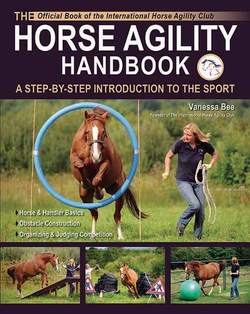Читать книгу The Horse Agility Handbook - Vanessa Bee - Страница 11
Оглавление4
CHAPTER 1
what is horse agility?
Horse Agility is a sport where the ultimate aim is for the handler to direct her completely free horse over, through and under obstacles. Note that while the horse needs to be comfortable and willing while at liberty, this process is not about “spook-busting”—it’s about myth-busting. You don’t want to “dumb your horse down”; you want to communicate
with him. My goal is never to “take the spook out of my horse,” as that’s what makes him a horse! I want my horse to be aware enough to think his way through an obstacle course, which is also why I ensure that agility courses I use never look the same and are always completed in a different obstacle order. I don’t want my horse to become an obedient “robot”—I want to keep him interested.
Horse Agility vs. Trick Training
Is Horse Agility really just teaching your horse to do tricks? By definition, it is: A “trick” is when an animal repeats an “unnatural” behavior for reward. However, by this definition, dressage, show jumping, and polo are also just “tricks”—in fact all horse sports!
What appeals to me about Horse Agility is that by working the horse free, he has the choice about whether he performs or not. Unfortunately, people have been conditioned to believe that horses are dangerous unless they are kept completely under control. Look through any horse magazine or visit any tack shop to see the fantastic array of gadgets designed for such a purpose. However, Horse Agility is all about training—not restraining. You will find there is very little in the way of equipment needed to join in the fun because the sport is about training the horse so that he knows what you want him to do without forcing him with gadgets. Horse Agility is a real testament to your ability as a trainer—you just have to be good at communicating with your horse.
What Would Your Horse Choose to Do?
When you watch dogs race round an agility course, it looks as if they’re having fun: They’re free to choose to run and jump and go around an obstacle if they wish. This kind of “fun” has never been seen in the horse
5
world—until now. Where did the myth come from that tells us we need to catch our horse, tie him up in order to perform such daily tasks as grooming or tacking up, then keep him under complete control in case he becomes dangerous in hand or under saddle?
Horse Agility throws all this nonsense out the window and shows you how to go right back to the beginning—back to basics—and think again how you can interact with a horse. To be any good, you need to start from this place. Horses do not need “collars” and “leads” all the time; they will come when you call them and happily do so if you ask in a language they understand. This brings me to a leading question: How do you know when a horse is “happy”? Maybe he doesn’t mind having his mouth tied closed or having his sides whipped? How can you tell? Well, you need to read the horse. You need to know what he looks like when he is—and isn’t—enjoying himself.
6
fig. 1.1 a
fig. 1.1 b
1.1 A & B The sport of Horse Agility is one of purpose—the work you do teaching him to handle obstacles in an agility course can be applied to a wide variety of real-life circumstances.
There are two personalities in this partnership: that of the horse and of the handler. The handler gets to choose whether or not she wants to do agility, but the horse does not. Would he choose to? The only way to find out is to start and see what he “says” about it.
So that you can be honest in your answer to this question, the first step is to learn what a “happy” and an “unhappy” horse looks like, and then let him go and see if he still wants to join in the agility fun!
The big advantage of Horse Agility in the way that I have developed it as a training tool is that it can prepare the horse for the real world. It is far better than simply accustoming him to the sights and sounds of flags and cones before venturing out onto the road, for example (figs. 1.1 a & b). You can use the techniques outlined in this book to help you and your horse get used to all manner of real-life situations.
This book shows you how to be safe and become really good at Horse Agility—that is, if you follow it through in the way I have outlined.
